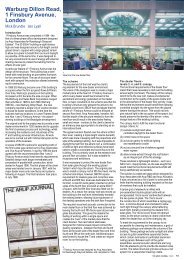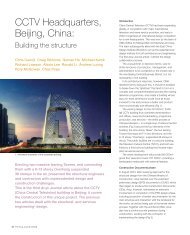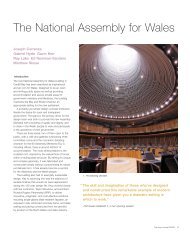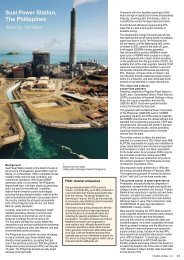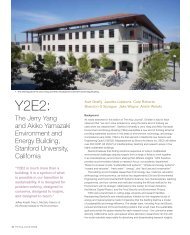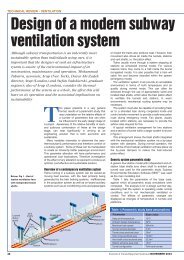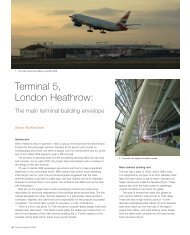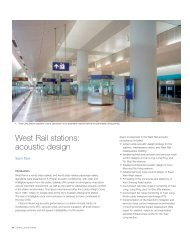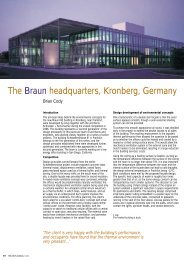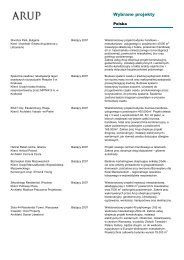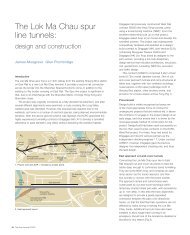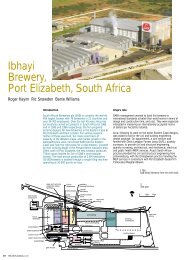3 Ngong Ping 360 John Batchelor, Suresh Tank 15 Waste as ... - Arup
3 Ngong Ping 360 John Batchelor, Suresh Tank 15 Waste as ... - Arup
3 Ngong Ping 360 John Batchelor, Suresh Tank 15 Waste as ... - Arup
You also want an ePaper? Increase the reach of your titles
YUMPU automatically turns print PDFs into web optimized ePapers that Google loves.
27. <strong>Arup</strong> <strong>as</strong>sessed materials for glazing the cable car cabins.<br />
Risk <strong>as</strong>sessment<br />
Tower 7<br />
46m<br />
483.0m<br />
MTRCL also appointed <strong>Arup</strong> to <strong>as</strong>sess the<br />
preferred materials for glazing the cable car cabins<br />
(Fig 27). These included polymethyl methacrylate<br />
(PMMA), polyethylene tetrephthalate copolymer<br />
(PETG), and polycarbonate (PC). An <strong>as</strong>sessment of<br />
the implications of these products from the fire<br />
hazard point of view w<strong>as</strong> required for MTRCL to<br />
come to a decision with the cabin manufacturers,<br />
who preferred a more expensive material.<br />
<strong>Arup</strong>’s fire hazard <strong>as</strong>sessment of these glazing<br />
materials included identification and <strong>as</strong>sessing the<br />
likelihood of potential ignition, fire scenarios during<br />
operation, related combustion behaviour and hazard<br />
levels, and a literature review of their use on similar<br />
projects. B<strong>as</strong>ed on the risk <strong>as</strong>sessment, MTRCL<br />
w<strong>as</strong> able to select the appropriate material that w<strong>as</strong><br />
also acceptable to the cabin manufacturers.<br />
Value engineering<br />
During Stage 2, <strong>Arup</strong> and Maeda proposed several<br />
value engineering initiatives. Once agreed with<br />
MTRCL, these were implemented and factored into<br />
the gainshare/painshare equation agreed between<br />
MTRCL and Maeda.<br />
At the Tung Chung terminal, the main structural<br />
frames were altered to use edge cantilevers for<br />
structural efficiency, and to resolve headroom<br />
problems. The roof geometry w<strong>as</strong> developed with<br />
straight members and the elimination of purlins for<br />
simplicity of fabrication, in spite of the complex<br />
roof shape (Fig 29).<br />
Foundation savings in the detailed design of the<br />
piles were achieved, but the more radical alternative<br />
of a raft instead of bored piles, which would have<br />
saved around 20% of the building cost with<br />
appropriate detailing, w<strong>as</strong> not adopted due to<br />
MTRCL’s concerns over the uncertain fill properties<br />
in the area.<br />
28. Computational evacuation software w<strong>as</strong> used to address<br />
the means of escape provision by calculating total<br />
evacuation time. This showed the risk of exposure to<br />
fire and smoke to be low, <strong>as</strong> the total evacuation time is<br />
less than five minutes.<br />
388m<br />
<strong>Ngong</strong> <strong>Ping</strong><br />
terminal<br />
29. Value engineering at Tung Chung terminal: the roof geometry w<strong>as</strong> developed with straight<br />
members and elimination of purlins for simplicity of fabrication, in spite of the complex shape.<br />
As already noted, the application of <strong>Arup</strong>’s fire engineering skills resulted in the<br />
deletion of a large drencher tank and system, whilst the foundation solutions for<br />
the AIAS achieved reduced pile quantities following the critical review by <strong>Arup</strong> of<br />
the piling design.<br />
At the two angle stations, <strong>Arup</strong> achieved reduced steel roof weights of around<br />
50% compared to the target cost figures by using more structurally efficient trussed<br />
frames, which also simplified the lifting problems for those stations in the country<br />
park are<strong>as</strong>. In addition, the minipile sizes were reduced and the excavations<br />
minimized by raising the foundation levels, thus reducing the amount of material to<br />
be disposed of by helicopter or mule.<br />
At the <strong>Ngong</strong> <strong>Ping</strong> terminal and theme village, steel frames were generally<br />
changed to concrete frames, and foundations reduced in size <strong>as</strong> well. Again at the<br />
theme village, the stream diversion gabion layout w<strong>as</strong> reduced to take advantage of<br />
existing rock outcrops found during excavation. Taking into account the approvals<br />
timing and design change costs, each works proposal w<strong>as</strong> evaluated on its merits<br />
and agreed with MTRCL before implementation within the target cost contract.<br />
The benefits of the target cost approach were clear from the alignment of all<br />
parties’ mutual interests towards seeking the most cost-effective solution overall for<br />
the project, using planned and agreed redesign, with extra design costs, to yield<br />
larger savings throughout construction.<br />
The <strong>Arup</strong> Journal 1/2008 13<br />
444.0m



